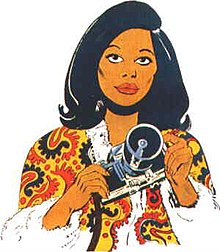
Summary
Friday Foster is an American newspaper comic strip, created and written by Jim Lawrence and illustrated by Jorge Longarón. It ran from January 18, 1970, to February 17, 1974[1] and was notable for featuring one of the first African-American women as the title character in a comic strip.[2] Jackie Ormes' Torchy Brown predated it, although it saw a more limited release in the Afro-American newspaper Pittsburgh Courier.
| Friday Foster | |
|---|---|
 Friday Foster, the title character of the comic strip | |
| Author(s) | Jim Lawrence Jorge Longarón |
| Current status/schedule | Concluded daily & Sunday strip |
| Launch date | January 18, 1970 |
| End date | February 17, 1974 |
| Syndicate(s) | Chicago Tribune Syndicate |
| Publisher(s) | Dell Comics |
| Genre(s) | Soap opera |
History edit
Jim Lawrence had been the writer of the London Daily Express comic strip, James Bond, when he became interested in creating a comic about a black character.[3] Spanish cartoonist Jorge Longarón was chosen as the illustrator, and the strip was syndicated by the Chicago Tribune Syndicate. The comic focused on the glamorous life of its title character, a former fashion model who became an assistant to a top fashion photographer, as described by comics historian Dave Karlen:
Starting out as an assistant to high-fashion photographer Shawn North, Friday after learning the ropes, eventually moved in front of the camera to become a world traveling supermodel leaving her troubled life in Harlem behind her. Early on, Lawrence's story lines had a harder edge showing the contrast of Friday's family with her street-wise brother trying to accept her newfound success in the world of magazine publishing. But soon its episodes changed focus to showcase more soap-opera thrills of romance and travel for the gorgeous African-American. Hong Kong, Paris, London, and even Africa were all shown with equal flair from the detailed artistic masterpieces produced by Longarón from his home in Barcelona.[4]
A 1970 issue of Jet reported on the debut of Friday Foster. The magazine stated that writer Lawrence lived in Summit, New Jersey and illustrator Longarón lived in Spain.[5] Lawrence, a veteran of the International Brigades in the Spanish Civil War had specifically sought a Spanish illustrator for the strip, at least in part because at the time Spanish illustrators were much cheaper than comparably skilled American illustrators.[6] The two communicated via postal mail and telephone calls.[5]
Because of the slow speed of the mail, Longarón mailed his drawings three weeks before they were scheduled to appear.[6] Still, the drawings sometimes did not arrive on time,[6] and artist Frank Springer did a small amount of uncredited work on the strip, recalling in the mid-2000s, "I knew the writer, who lived here in New Jersey, ... [and] I got a call a couple of times from Lawrence who said they hadn't gotten the material through from Spain" and asked Springer to fill in. "I guess over the years I did two Sunday pages, maybe three."[7]
Longarón, from Barcelona, had never been in New York until he made a brief trip there to sign the contract to do the comic. Even then, he never actually set foot in Harlem, though he did pass through it taking photos from a taxi for future reference.[6] He drew the comic using a technique he had already established, with a sharpened pencil dipped in ink.[6] He worked in part from photographs. He based Friday's general appearance on a particular African American model from Playboy, but also used his own mother and aunt (both artists themselves) as models.[6]
Dell Comics published a single issue of a Friday Foster comic book (October 1972), written by Joe Gill and illustrated by Jack Sparling.
In 1975, Friday Foster was adapted into a blaxploitation feature film of the same name, starring Pam Grier.
In September 2019, the Friday Foster character appeared in a Dick Tracy story drawn by Andrew Pepoy.
The comic is the subject of a temporary exhibit "Longaron i Friday Foster. L'heroïna inesperada" 20 March 2024 through 24 June 2024 at the Museu Nacional d'Art de Catalunya in Barcelona.[8]
Further reading edit
- The Spectacular Sisterhood of Superwomen: Awesome Female Characters from Comic Book History by Hope Nicholson, Quirk Books (2017)
See also edit
References edit
- ^ Holtz, Allan (2012). American Newspaper Comics: An Encyclopedic Reference Guide. Ann Arbor: The University of Michigan Press. p. 163. ISBN 9780472117567.
- ^ Friday Foster at Don Markstein's Toonopedia. Archived from the original on July 30, 2016.
- ^ Friday Foster, The New Yorker, page 33, March 21, 1970
- ^ Karlen, Dave (June 19, 2009). "Buried Treasure: Lawrence & Longaron's Friday Foster". DaveKarlen Original Art Blog. Retrieved 2014-03-18.
- ^ a b Journalism - Black Career Girl Comic Strip Debuts in Cleveland, Jet, page 19, February 12, 1970
- ^ a b c d e f Sesé, Teresa (2024-03-26). "'Black power' del Guinardó". La Vanguardia (in Spanish). Barcelona. pp. 35–36.
- ^ Springer in Best, Daniel (January 10, 2008). "Looking Back with Frank Springer". 20th Century Danny Boy. Archived from the original on May 24, 2012. Retrieved 2014-03-17.
- ^ "Longaron i Friday Foster. L'heroïna inesperada". Museu Nacional d'Art de Catalunya (in Catalan). Retrieved 2024-03-27.


